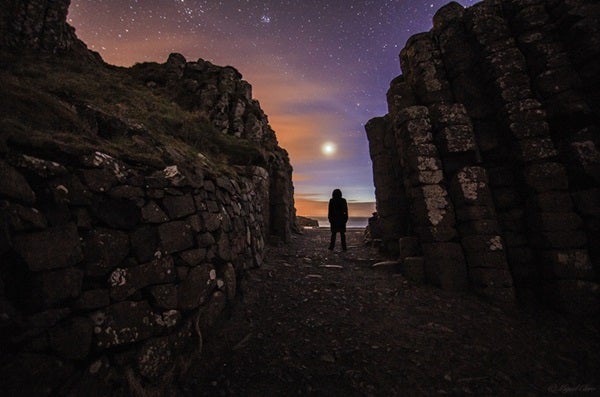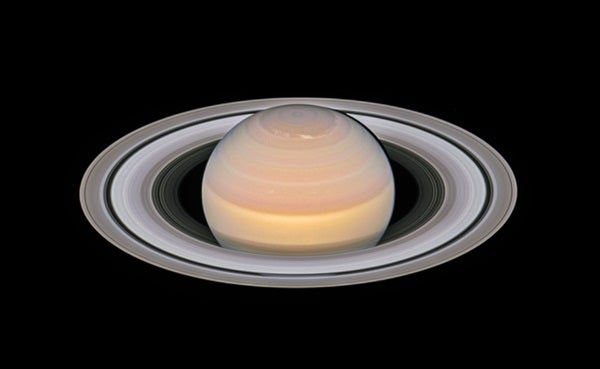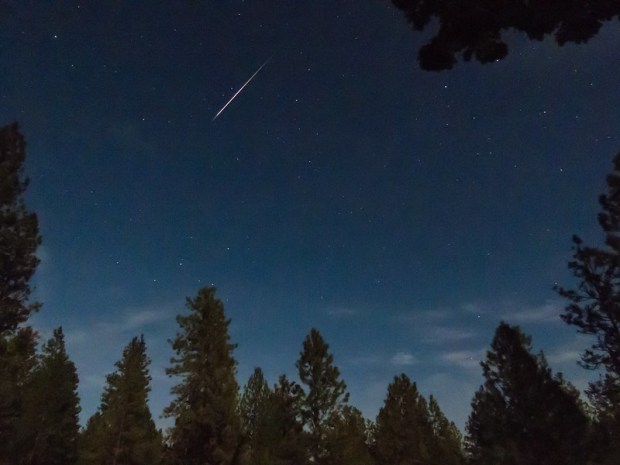Although the Moon reached its Full phase early this morning (at 12:39 a.m. EST), you’ll be hard-pressed to see it as less than Full tonight. Luna rises about an hour after sundown and climbs highest in the south shortly before 1 a.m. local time. The Moon spends the night among the background stars of Taurus the Bull.
Thanksgiving weekend signifies autumn to many people, but the stars of both summer and winter appear prominent in late November’s evening sky. If you head out around 9 p.m. local time and look toward the west, you’ll see the bright stars of the Summer Triangle. These three luminaries — Vega, Deneb, and Altair — stand out nicely. Deneb appears highest (nearly halfway to the zenith), while the brightest, Vega, lies farthest to the north. Now, if you turn around and face east, you’ll find stars normally associated with winter. Betelgeuse, Rigel, Aldebaran, and Capella all clear the horizon before 8 p.m. and appear conspicuous an hour later.
Saturday, November 24
While the stars of summer and winter remain on view these late November evenings, the stars of spring are not so lucky. The Big Dipper swings low in the north at this time of year. Although this conspicuous asterism never sets from much of the United States and Canada, it does come close. And the star at the end of the handle — magnitude 1.9 Eta () Ursae Majoris — does dip below the horizon around 9 p.m. local time for viewers south of 40° north latitude.
Sunday, November 25
Neptune’s westward motion against the background stars comes to a halt today. The distant planet appears highest in the south near the end of evening twilight and doesn’t set until around midnight. The magnitude 7.9 world lies in Aquarius, 2° due east of the 4th-magnitude star Lambda () Aquarii. You’ll need binoculars to spy Neptune and a telescope to see its blue-gray disk, which spans 2.3″.
Mars continues to rule the evening sky from its perch in Aquarius. The Red Planet receives a visitor from Earth Monday afternoon when NASA’s Insight spacecraft lands on Elysium Planitia.
Monday, November 26
Mars continues to put on a great show these November evenings. The Red Planet appears 40° above the southern horizon as twilight fades to darkness. The world shines at magnitude –0.1, brighter than any other early evening object save for the Moon, against the faint backdrop of Aquarius the Water-bearer. A telescope reveals a disk that spans 10″ and should show some subtle surface features. As you gaze at Mars this evening, NASA’s latest planetary spacecraft, InSight (short for Interior Exploration using Seismic Investigations, Geodesy and Heat Transport), should be resting comfortably on the surface of Elysium Planitia following its landing around 3 p.m. EST. For the next two years, InSight will study Mars’ crust, mantle, and core to learn more about the planet’s interior and help scientists understand how the terrestrial planets formed.
Jupiter passes behind the Sun from our perspective, a configuration astronomers call conjunction, at 2 a.m. EST. Needless to say, our star’s glare makes it impossible to see the planet. Jupiter will return to view in the morning sky in a couple of weeks.
The Moon reaches perigee, the closest point in its orbit around Earth, at 7:12 a.m. EST. It then lies 227,807 miles (366,620 kilometers) away from us.
Tuesday, November 27
The variable star Algol in Perseus reaches minimum brightness at 4:15 a.m. EST. If you start watching late on the evening of the 26th, you can see its brightness diminish by 70 percent over the course of about 5 hours as its magnitude drops from 2.1 to 3.4. This eclipsing binary star runs through a cycle from minimum to maximum and back every 2.87 days. Algol appears nearly overhead around 11 p.m. local time and remains visible in the northwest until dawn.
Mercury reaches inferior conjunction, passing between the Sun and Earth, at 4 a.m. EST. The innermost planet will return to view before dawn within a week.
Wednesday, November 28
Algol can guide you to one of the finest binocular star clusters in the late autumn sky. Just after darkness falls, target the variable star through binoculars and place it at the bottom of your field of view. At the top of the field, you should see a hazy patch of light roughly the size of the Full Moon. This is M34, a collection of roughly 100 suns near Perseus’ border with Andromeda. Through 10×50 binoculars, M34’s brightest stars appear to twinkle against the unresolved glow of the cluster’s fainter members. To find more objects worth exploring these autumn nights, see “November’s 50 finest deep-sky objects” in the November issue of Astronomy.
Thursday, November 29
Last Quarter Moon arrives at 7:19 p.m. EST. It rises in the eastern sky shortly before midnight local time and reaches its peak in the south near sunrise tomorrow morning, by which time it appears slightly less than half-lit. Throughout this period, our satellite resides among the background stars of Leo the Lion.
Friday, November 30
Look high in the south after darkness falls this week and you should see autumn’s most conspicuous star group. The Great Square of Pegasus stands out in the evening sky at this time of year and, because it lies due south, it looks like a nearly perfect square. These four almost equally bright stars form the body of Pegasus the Winged Horse. The fainter stars that represent the rest of this constellation’s shape trail off to the square’s west.
Saturday, December 1
Venus appears brilliant from the time it rises a little before 4 a.m. local time until close to sunrise some three hours later. It stands about 25° above the southeastern horizon an hour before the Sun comes up. Shining at magnitude –4.9, it appears slightly brighter today than at any other time during this morning apparition. (The difference is essentially imperceptible, however — it appears less than 0.01 magnitude brighter today than it did yesterday or will tomorrow.) When viewed through a telescope this morning, Venus spans 40″ and appears one-quarter lit.
The days of viewing Saturn in the evening sky are dwindling rapidly. You can find the ringed world about 10° high in the southwest 45 minutes after sunset. The planet shines at magnitude 0.5, more than a full magnitude brighter than any of the background stars in its host constellation, Sagittarius the Archer. Although the best views of Saturn through a telescope came earlier in this apparition, it never hurts to take a final look. This week, the planet’s disk measures 15″ across while the ring system spans 35″ and tilts 26° to our line of sight.












